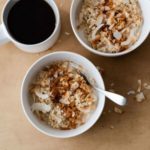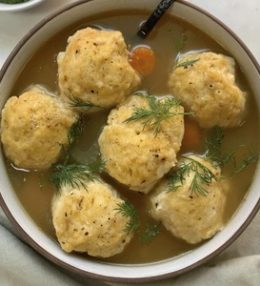Unlike quick-cooking oats, old-fashioned oatmeal has time to turn extra-creamy and luscious with just a few minutes more of cooking time. With a bit of milk and the toppings of your choice, this oatmeal recipe can be your go-to morning staple for a filling, healthy breakfast.
The Best Oatmeal Toppings to Try
Here’s a list of some of our favorite toppings that can elevate a plain bowl of oatmeal into something grand—plus add more nutrition and fiber to your day. Fruit (fresh, frozen or dried): bananas or apples; chopped stone fruits like cherries, apricots, peaches, mangoes and nectarines; berries; applesauce, jam or preserves. Nuts or seeds: crushed almonds, hazelnuts, pecans, pistachios, walnuts, peanut butter; chia seeds, ground flaxseeds and sesame seeds. Sweeteners: brown sugar, honey maple syrup, shaved dark chocolate. Spices: ginger, cardamom, cinnamon or nutmeg. Dairy and dairy alternatives: milk, yogurt or plant-based, calcium-fortified milk.
Combinations to try
- 1 soft-boiled egg + 1/3 cup sauteed spinach + 1 teaspoon chili crisp or togarashi seasoning (omit honey and cinnamon from base recipe)
- 1/4 cup shredded carrot + 1 tablespoon chopped toasted walnuts + 1 tablespoon golden raisins + 1/4 teaspoon cinnamon
- 1/2 medium banana, sliced + 1 tablespoon peanut butter + 1 teaspoon chia seeds + 1 teaspoon brown sugar
- 1/4 cup blueberries + 1 tablespoon toasted coconut flakes + 1 tablespoon chopped toasted macadamia nuts + 1 teaspoon honey
- 1/4 cup sliced peaches + 2 tablespoons cinnamon granola + 2 tablespoons vanilla yogurt
Photographer: Jen Causey, Food Stylist: Chelsea Zimmer, Prop Stylist: Lydia Purcell
Ingredients
-
1 cup water or low-fat milk
-
Pinch of salt
-
½ cup rolled oats
-
2 tablespoons low-fat milk for serving
-
1 to 2 teaspoons honey, cane sugar or brown sugar for serving
-
Pinch of cinnamon
Directions
-
Combine water (or milk) and salt in a small saucepan. Bring to a boil. Stir in oats and reduce heat to medium; cook, stirring occasionally, for 5 minutes. Remove from heat, cover and let stand for 2 to 3 minutes.
Photographer: Jen Causey, Food Stylist: Chelsea Zimmer, Prop Stylist: Lydia Purcell
-
Top with milk, sweetener, cinnamon, dried fruits or nuts, if desired.
Photographer: Jen Causey, Food Stylist: Chelsea Zimmer, Prop Stylist: Lydia Purcell
Frequently Asked Questions
-
Whether you choose steel-cut oats, old-fashioned (rolled) oats or plain instant oats, the nutrition is the same. You’ll get complex carbs, fiber, plant protein, vitamins and minerals. Eating oats has been linked with reduced cholesterol levels, balanced blood sugar and a healthy digestive tract.
-
Are old-fashioned oats gluten-free?
The answer is sometimes. People with celiac disease or gluten sensitivity should use oats that are labeled “gluten-free,” as oats are often cross-contaminated with wheat and barley.
-
What’s the difference between old-fashioned oats and quick oats?
Both old-fashioned oats and quick oats are oat groats that are steamed and pressed (or rolled) into flakes. Old-fashioned oats are steamed and pressed a little less than quick-cooking oats, which helps them retain their texture when they’re cooked. Old-fashioned oats take longer to cook than quick-cooking oats (about five minutes for old-fashioned oats versus one minute for quick oats).
-
Can Old-Fashioned Oatmeal be made ahead of time?
Absolutely. You can whip up a batch one day and enjoy it for the next five days. Make sure you cool the oatmeal before adding it to airtight containers and placing it in the fridge. It can easily be reheated on the stove or in the microwave, but it’s best to add a little milk or water to it before doing so.
-
Can I make Old-Fashioned Oatmeal in the microwave?
Yes! Combine water (or milk), salt and oats in a 2-cup microwave-safe bowl. Microwave on High for 2 1/2 to 3 minutes. Stir before serving.
Additional reporting by Carrie Myers, M.S., Hilary Meyer and Linda Frahm
Originally appeared: EatingWell.com, December 2018
Nutrition Facts (per serving)
| 150 | Calories |
| 3g | Fat |
| 27g | Carbs |
| 5g | Protein |
| Nutrition Facts | |
|---|---|
|
Servings Per Recipe 1 |
|
|
Serving Size 1 cup |
|
|
Calories 150 |
|
| % Daily Value * | |
|
Total Carbohydrate 27g |
10% |
|
Dietary Fiber 4g |
14% |
|
Total Sugars 1g |
|
|
Protein 5g |
10% |
|
Total Fat 3g |
4% |
|
Saturated Fat 1g |
3% |
|
Folate 20mcg |
5% |
|
Sodium 152mg |
7% |
|
Calcium 27mg |
2% |
|
Iron 1mg |
8% |
|
Magnesium 42mg |
10% |
|
Potassium 152mg |
3% |
Nutrition information is calculated by a registered dietitian using an ingredient database but should be considered an estimate.
* Daily Values (DVs) are the recommended amounts of nutrients to consume each day. Percent Daily Value (%DV) found on nutrition labels tells you how much a serving of a particular food or recipe contributes to each of those total recommended amounts. Per the Food and Drug Administration (FDA), the daily value is based on a standard 2,000 calorie diet. Depending on your calorie needs or if you have a health condition, you may need more or less of particular nutrients. (For example, it’s recommended that people following a heart-healthy diet eat less sodium on a daily basis compared to those following a standard diet.)
(-) Information is not currently available for this nutrient. If you are following a special diet for medical reasons, be sure to consult with your primary care provider or a registered dietitian to better understand your personal nutrition needs.
Unlike quick-cooking oats, old-fashioned oatmeal has time to turn extra-creamy and luscious with just a few minutes more of cooking time. With a bit of milk and the toppings of your choice, this oatmeal recipe can be your go-to morning staple for a filling, healthy breakfast. The Best Oatmeal Toppings to Try Here’s a list of some of our favorite toppings that can elevate a plain bowl of oatmeal into something grand—plus add more nutrition and fiber to your day. Fruit (fresh, frozen or dried): bananas or apples; chopped stone fruits like cherries, apricots, peaches, mangoes and nectarines; berries; applesauce, jam or preserves. Nuts or seeds: crushed almonds, hazelnuts, pecans, pistachios, walnuts, peanut butter; chia seeds, ground flaxseeds and sesame seeds. Sweeteners: brown sugar, honey maple syrup, shaved dark chocolate. Spices: ginger, cardamom, cinnamon or nutmeg. Dairy and dairy alternatives: milk, yogurt or plant-based, calcium-fortified milk. Combinations to try 1 soft-boiled egg + 1/3 cup sauteed spinach + 1 teaspoon chili crisp or togarashi seasoning (omit honey and cinnamon from base recipe)1/4 cup shredded carrot + 1 tablespoon chopped toasted walnuts + 1 tablespoon golden raisins + 1/4 teaspoon cinnamon1/2 medium banana, sliced + 1 tablespoon peanut butter + 1 teaspoon chia seeds + 1 teaspoon brown sugar1/4 cup blueberries + 1 tablespoon toasted coconut flakes + 1 tablespoon chopped toasted macadamia nuts + 1 teaspoon honey1/4 cup sliced peaches + 2 tablespoons cinnamon granola + 2 tablespoons vanilla yogurt Photographer: Jen Causey, Food Stylist: Chelsea Zimmer, Prop Stylist: Lydia Purcell Ingredients 1 cup water or low-fat milk Pinch of salt ½ cup rolled oats 2 tablespoons low-fat milk for serving 1 to 2 teaspoons honey, cane sugar or brown sugar for serving Pinch of cinnamon Directions Combine water (or milk) and salt in a small saucepan. Bring to a boil. Stir in oats and reduce heat to medium; cook, stirring occasionally, for 5 minutes. Remove from heat, cover and let stand for 2 to 3 minutes. Photographer: Jen Causey, Food Stylist: Chelsea Zimmer, Prop Stylist: Lydia Purcell Top with milk, sweetener, cinnamon, dried fruits or nuts, if desired. Photographer: Jen Causey, Food Stylist: Chelsea Zimmer, Prop Stylist: Lydia Purcell Frequently Asked Questions Whether you choose steel-cut oats, old-fashioned (rolled) oats or plain instant oats, the nutrition is the same. You’ll get complex carbs, fiber, plant protein, vitamins and minerals. Eating oats has been linked with reduced cholesterol levels, balanced blood sugar and a healthy digestive tract. Are old-fashioned oats gluten-free? The answer is sometimes. People with celiac disease or gluten sensitivity should use oats that are labeled “gluten-free,” as oats are often cross-contaminated with wheat and barley. What’s the difference between old-fashioned oats and quick oats? Both old-fashioned oats and quick oats are oat groats that are steamed and pressed (or rolled) into flakes. Old-fashioned oats are steamed and pressed a little less than quick-cooking oats, which helps them retain their texture when they’re cooked. Old-fashioned oats take longer to cook than quick-cooking oats (about five minutes for old-fashioned oats versus one minute for quick oats). Can Old-Fashioned Oatmeal be made ahead of time? Absolutely. You can whip up a batch one day and enjoy it for the next five days. Make sure you cool the oatmeal before adding it to airtight containers and placing it in the fridge. It can easily be reheated on the stove or in the microwave, but it’s best to add a little milk or water to it before doing so. Can I make Old-Fashioned Oatmeal in the microwave? Yes! Combine water (or milk), salt and oats in a 2-cup microwave-safe bowl. Microwave on High for 2 1/2 to 3 minutes. Stir before serving. Additional reporting by Carrie Myers, M.S., Hilary Meyer and Linda Frahm Originally appeared: EatingWell.com, December 2018 Nutrition Facts (per serving) 150 Calories 3g Fat 27g Carbs 5g Protein Nutrition Facts Servings Per Recipe 1 Serving Size 1 cup Calories 150 % Daily Value * Total Carbohydrate 27g 10% Dietary Fiber 4g 14% Total Sugars 1g Protein 5g 10% Total Fat 3g 4% Saturated Fat 1g 3% Folate 20mcg 5% Sodium 152mg 7% Calcium 27mg 2% Iron 1mg 8% Magnesium 42mg 10% Potassium 152mg 3% Nutrition information is calculated by a registered dietitian using an ingredient database but should be considered an estimate. * Daily Values (DVs) are the recommended amounts of nutrients to consume each day. Percent Daily Value (%DV) found on nutrition labels tells you how much a serving of a particular food or recipe contributes to each of those total recommended amounts. Per the Food and Drug Administration (FDA), the daily value is based on a standard 2,000 calorie diet. Depending on your calorie needs or if you have a health condition, you may need more or less of particular nutrients. (For example, it’s recommended that people following a heart-healthy diet eat less sodium on a daily basis compared to those following a standard diet.) (-) Information is not currently available for this nutrient. If you are following a special diet for medical reasons, be sure to consult with your primary care provider or a registered dietitian to better understand your personal nutrition needs.
Coconut Chai-Spiced Oatmeal










